catalytic converter AUDI A6 2014 Owners Manual
[x] Cancel search | Manufacturer: AUDI, Model Year: 2014, Model line: A6, Model: AUDI A6 2014Pages: 304, PDF Size: 76.32 MB
Page 5 of 304

Error messages . . . . . . . . . . . . . . . . . . 125
Trailer hitch . . . . . . . . . . . . . . . . . . . . . 125
Homelink
Universal remote control ... .. .. .. . .
S afet y fir st ... ...... ... .. .. .. . .
Dri ving Safely ...... ... .. .. .. . .
Gene ral notes ..... .... ... .. .. .. . .
Proper occupant seating posit ions . . .
Driver and passenger side footwell . . .
Pedal area .. ................. .. . .
Stowing luggage ............. ... .
Report ing Safety Defects .......... . 126
126
12
8
128
128
129
133
133
1 34
136
Safety belts . . . . . . . . . . . . . . . . . . . 138
Ge neral notes . . . . . . . . . . . . . . . . . . . . 138
Why safety be lts? . . . . . . . . . . . . . . . . 139
Safety belts . . . . . . . . . . . . . . . . . . . . . 1 41
Safety bel t pre tens io ners . . . . . . . . . . 1 45
Airbag system ........... .. .. .. 147
I mpo rtant th ings to know . . . . . . . . . . 147
Fr ont airbags . . . . . . . . . . . . . . . . . . . . 1 51
M on itoring the Advanced Airbag
System . . . . . . . . . . . . . . . . . . . . . . . . . 159
Knee airbags . . . . . . . . . . . . . . . . . . . . . 164
Side airbags . . . . . . . . . . . . . . . . . . . . . 167
Side curta in a irbags . . . . . . . . . . . . . . . 170
Child Safety ............... .. . .
Important things to know .. .. .. .. . .
C hi ld safety seats ... ...... .... .. . .
Install ing a child safety seat .. .. .. . .
L ATC H Lower ancho rages and tethe rs
for ch ild ren . ............. .... .. . .
Addit ional Information
Audi pre sense ..... ... .. .. .. . .
P reven tat ive passenger p rotection
Vehicle operat ion ..... .. .. .. . .
Intelligent technology .. .. .. . .
Not ice about da ta re cor ded by veh icle
control mod ules ... .... ... .. .. .. . .
Elect ronic Stabilization Control (ESC) .
Braking .... .. .... .. .... ... .. .. . .
E lectro-mechanical power assist . .. . . 173
173
179
184
187
19
1
192
19 2
194
194
194
194
196
198
Table of contents 3
Driving with your q uattro . . . . . . . . . . 198
Energy management . . . . . . . . . . . . . . 199
Driving and environment . . . . . 201
The first 1,000 miles (1,500 km) and
afterwards . . . . . . . . . . . . . . . . . . . . . . 201
Catalytic converter . . . . . . . . . . . . . . . . 202
Diesel particulate f ilter . . . . . . . . . . . . 202
Avoid damaging the vehicle . . . . . . . . . 203
Drivi ng throug h wate r on roads . . . . . 203
Sh utting down vehicle . . . . . . . . . . . . . 203
Operate your vehicle economically a nd
min imi ze poll ution . . . . . . . . . . . . . . . . 203
Trailer towing . . . . . . . . . . . . . . . . . 206
Drivi ng with a trailer . . . . . . . . . . . . . . 206
T rail er tow ing t ips . . . . . . . . . . . . . . . . 208
Vehicle care . . . . . . . . . . . . . . . . . . . 210
Vehicle care and cleaning . . . . . 210
Genera l informa tion . . . . . . . . . . . . . . 210
Car was hes . . . . . . . . . . . . . . . . . . . . . . 210
Cleaning and care information . . . . . . 211
Fuel supply and filling your
fuel tank ... .... .. . .. .. ..... ... .
215
Gasoline . . . . . . . . . . . . . . . . . . . . . . . . 215
Diesel f uel . . . . . . . . . . . . . . . . . . . . . . 216
Fuel tank.. .. .. .. ... ............ . 217
Se lective cata lytic reduction . . . . . . . . 220
Checking and filling . . . . . . . . . . . 224
E n gine hood . . . . . . . . . . . . . . . . . . . . . 224
E n gine compartment . . . . . . . . . . . . . . 226
Engine oil . . . . . . . . . . . . . . . . . . . . . . . 226
En gine cooling system . . . . . . . . . . . . . 231
Br ake fluid . . . . . . . . . . . . . . . . . . . . . . 234
B attery . . . . . . . . . . . . . . . . . . . . . . . . . 235
Windsh ie ld/headligh t washer
container . . . . . . . . . . . . . . . . . . . . . . . 238
Tires and wheels . . . . . . . . . . . . . . 24 0
Tires . . . . . . . . . . . . . . . . . . . . . . . . . . . 240
Tire pressure monitoring system . . . . 258
•
•
Page 14 of 304
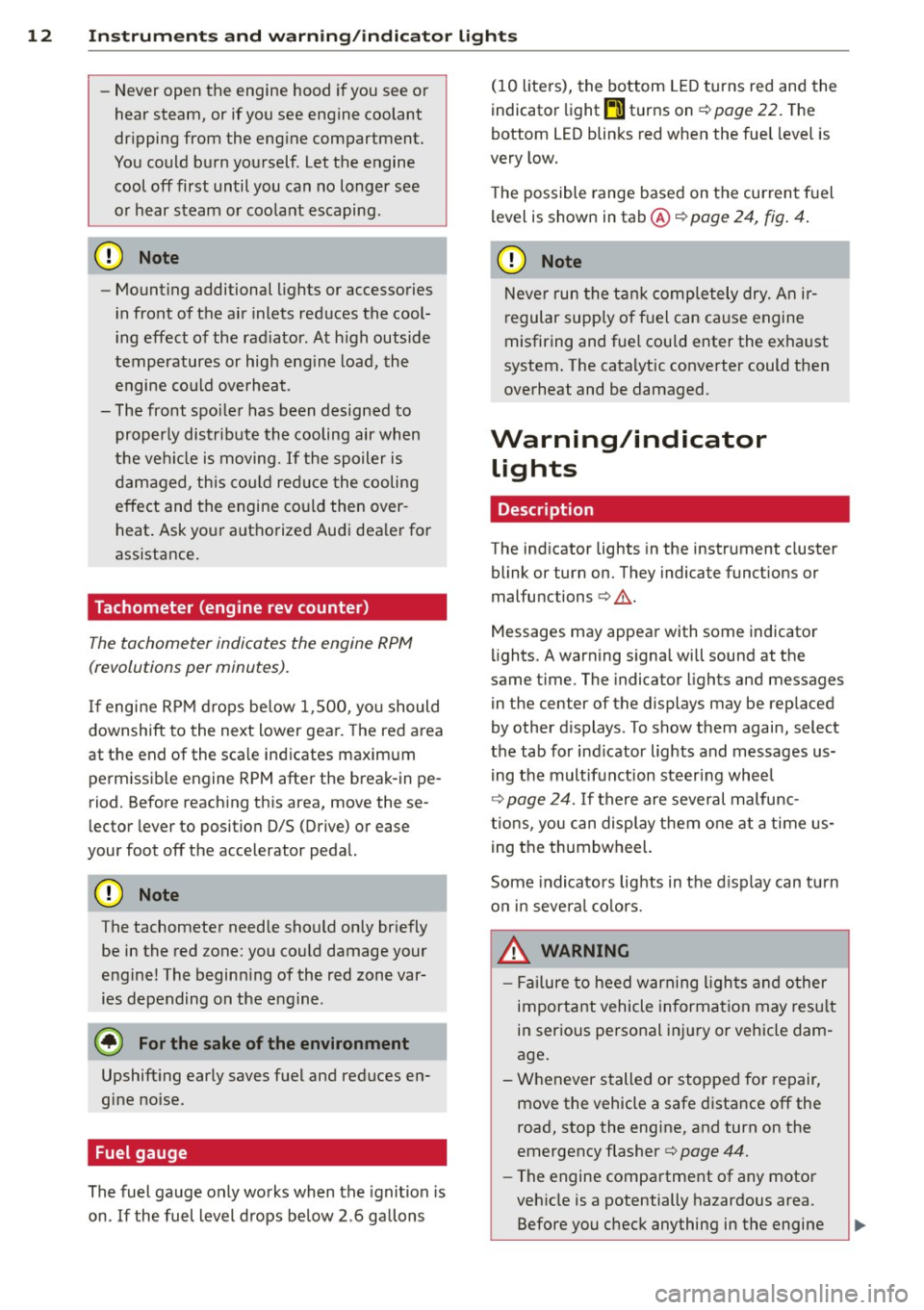
12 Instrum ent s and w arn ing /indic ato r light s
-Never open the engine hood if you see or
hear steam, or if you see engine coolant
dripping from the engine compartment.
You could burn yourself . Let the engine
cool off first until you can no longer see
o r hear steam or coo lant escaping.
@ Note
- Mounting additional lights or accessories
i n front of the a ir inlets reduces the cool
i ng effect of the rad iator . At h igh outside
temperatures or high eng ine load, the
engine could overheat.
- The front spo iler has been designed to
proper ly distribute the cooling air when
t h e ve hicle is moving.
If the spoiler is
dam aged, th is co uld red uce the cooling
effect and the engine co uld then over
heat . Ask your authorized Audi dea ler for
assistance .
Tachometer (engine rev counter)
The tachometer indicates the engine RPM
(revolutions per minutes).
If engine RP M drops be low 1,500, yo u should
downshift to the next lower gear. The red a rea
at the end of the sca le indicates maximum
perm iss ib le engine RPM after the break-in pe
riod. Before reaching this area, move these
lector lever to position D/S (Drive) or ease
your foot off the accelerator pedal.
(D Note
The tachometer needle should on ly br iefly
be in the red zone: you could damage your
engine! The beginn ing of the red zone var
ies depending on the engine .
@ For the sake of the environment
Upshifting early saves fuel and reduces en
gine noise.
Fuel gauge
The fuel gauge only works when the ignition is
on .
If the fuel level d rops below 2 . 6 ga llons (10 liters), the bottom LED turns red and the
indicator light
Em turns on
¢ page 22. The
bottom LED blinks red when the fuel level is
very low.
T he possible range based on the current fuel
level is shown in tab@<=>
page 24, fig . 4 .
(D Note
Never run the tank completely dry. An ir
r egular supply of f uel can cause engine
misfiring and fuel could enter the ex ha ust
system . The catalytic converter could then
overheat and be damaged.
Warning/indicator Lights
Description
The ind icator lights in the instrument cluster
blink or turn on. They indicate funct ions or
malfunctions <=>,& .
Messages may appear with some indicato r
lights. A warning signal will sound at the
same t ime. The indicator lights and messages
in the center of the displays may be rep laced
by other d isplays . To show them again, select
the tab for ind icator lights and messages us
i ng the multifunction steering wheel
Q page 24. If t here are several malfunc
t ions, you can display them one at a time us
ing the thumbwheel.
Some indicato rs lights in the d isplay can turn
on in severa l co lors.
A WARNING
- F ailure to heed w arning l igh ts and other
important vehicle in forma tion may res ult
in ser io us personal inj ury or vehicle dam
age .
- Whenever stalled or stopped for repair, move the vehicle a safe d istance off the
road, stop the engine, and turn on the
emergency flasher<=>
page 44.
-The engine compartment of any motor
veh icle is a potentially hazardous area.
Before you chec k anything in the engine
Page 204 of 304
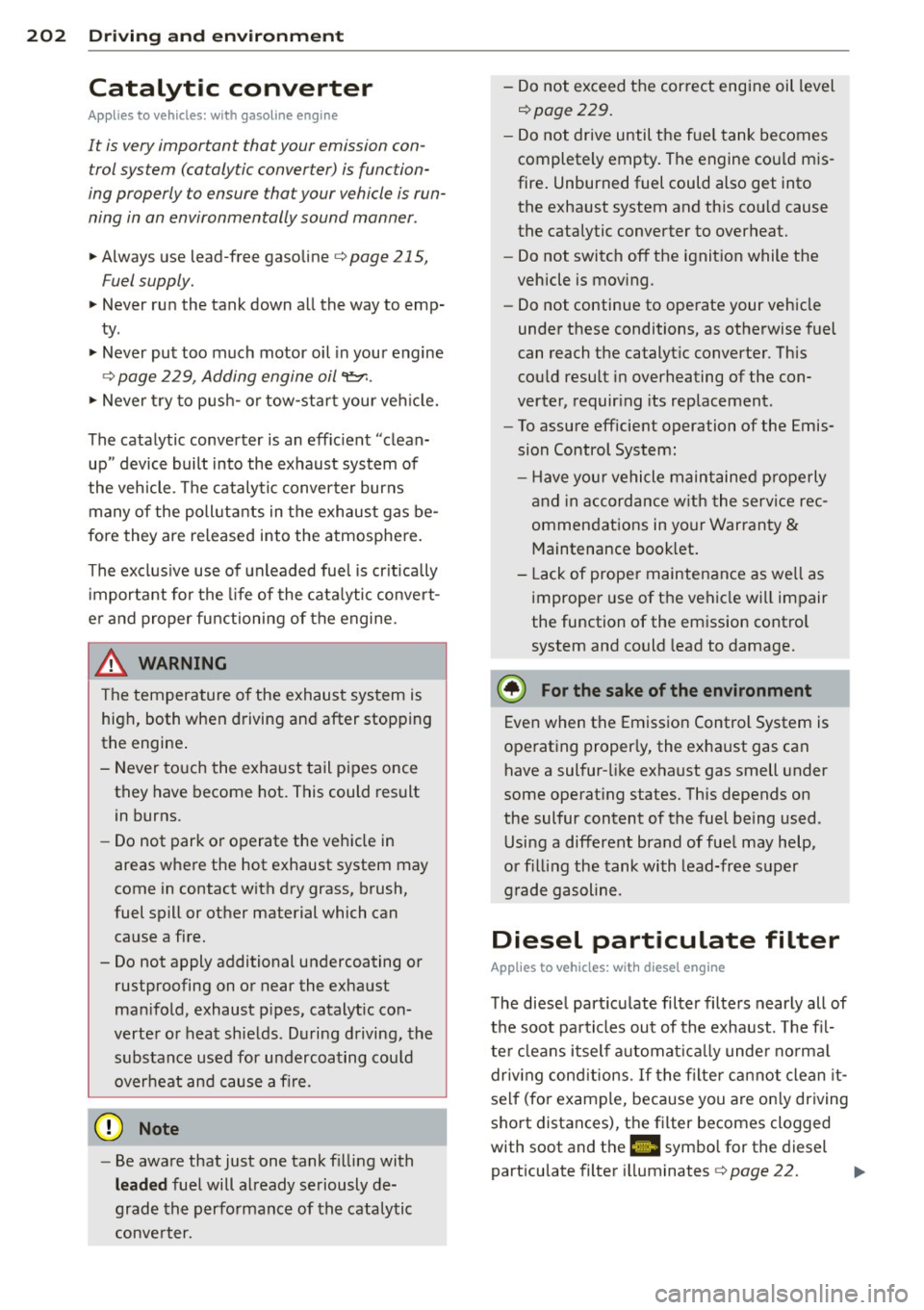
202 Driving and en vir onm ent
Catalytic converter
Appl ies to vehicles: with gasoline e ngin e
It is very important that your emission con
trol system (catalytic converter) is function
ing properly to ensure that your vehicle is run
ning in an environmentally sound manner .
.. Always use lead-free gasoline¢ page 215,
Fuel supply .
.. Never run the tank down all the way to emp-
ty .
.. Never put too much motor oil in your engine
¢ page 229, Adding engine oil
The catalytic converter is an eff ic ient "clean
up" device built into the exhaust system of
the vehicle. The catalyti c converter burns
many of the pollutants in the exhaust gas be
fore they are released into the atmosphere.
The exclus ive use of unleaded fuel is cr itically
important for the l ife of the cata lytic convert
e r and proper functioning of the engine.
A WARNING
T he temperature of the exhaust system is
high, both when driving and after stopping
the engine .
- Never touch the exhaust tail pipes once
they have become hot. This could result
in burns.
- Do not park or operate the vehicle in
areas where the hot exhaust system may
come in contact with dry grass, brush,
fuel spill or other material which can
cause a fire.
- Do not apply additional undercoating or
rustproofing on or near the exhaust
man ifold, exhaust p ipes, catalytic con
verter or heat shields . During driving, the
substance used for undercoating cou ld
overheat and cause a fire.
@) Note
- Be aware that just one tank f illing with
leaded fuel will al ready seriously de
grade the perfo rmance of the cata lytic
conve rter. -
Do not exceed the correct engine oil level
¢page 229.
-Do not drive until the fue l tank becomes
completely empty . The engine co uld m is
fire . Unburned fuel could also get into
the exhaust system and this cou ld cause
the catalytic converter to overheat.
- Do not switch off the ignition while the
vehicle is mov ing .
- Do not continue to ope rate your vehicle
under these conditions, as otherwise fuel
can reach the catalyt ic converter. Th is
cou ld result in overheating of the con
verter, requir ing its replacement .
- To assure efficient operation of the Emis
sion Control System:
- Have you r vehicle maintained p roperly
and in accordance w ith the service rec
ommendations in your Warranty & Maintenance book let.
- Lack of prope r maintenance as we ll as
improper use of the vehicle wi ll impair
the function of the em ission contro l
system and could lead to damage.
@) For the sa ke of the en vironment
Even when the Emission Control System is
ope rat ing properly, the exhaust gas can
have a sulfur-like exhaust gas smell under
some operat ing states. This depends on
the sulfur content of the fuel being used .
Usi ng a different brand of fuel may help,
or f illing the tank with lead-free super
grade gasoline.
Diesel particulate filter
Applies to vehicles: with diese l eng ine
The diesel part icu late filter filters nearly all of
the soot pa rticles out of the exhaust . T he fil
te r cleans itself automat ica lly unde r no rma l
dr iv ing cond itions . If the filte r cannot clean it
self (for example, because you are on ly driving
short distances), the filter becomes clogged
with soot and the
II symbol for the diesel
particulate filter ill uminates ¢
page 22. ..,.
Page 207 of 304
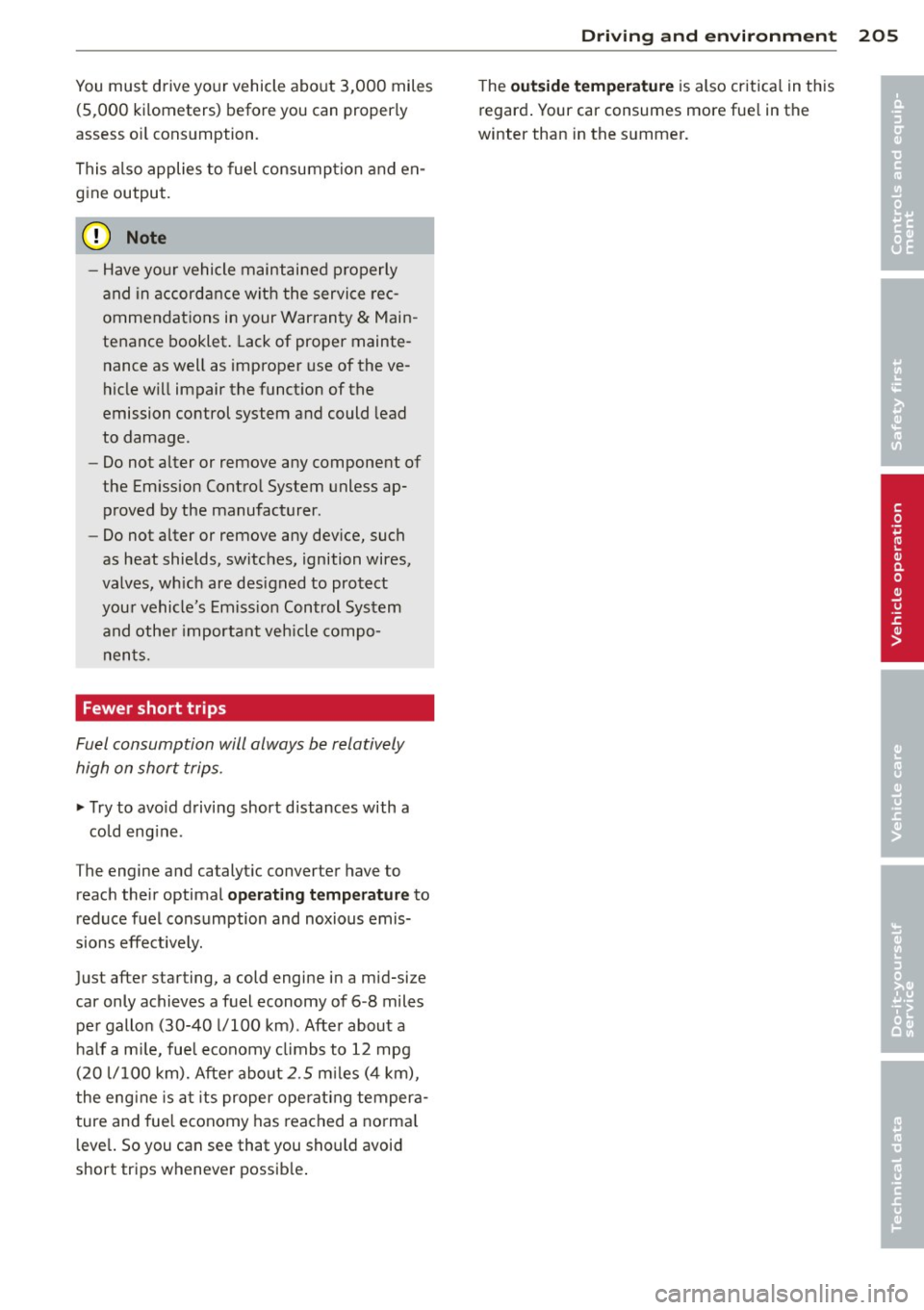
You must drive your vehicle about 3,000 miles (5,000 kilometers) before you can properly
assess oil consumption.
This also applies to fuel consumption and en
gine output.
(D Note
- Have your vehicle maintained properly
and in accordance with the service rec
ommendations in your Warranty
& Main
tenance booklet. Lack of proper mainte
nance as well as improper use of the ve
hicle will impair the function of the
emission control system and could lead
to damage .
- Do not alter or remove any component of
the Emission Control System unless ap
proved by the manufacturer.
- Do not alter or remove any device, such
as heat shields, switches, ignition wires,
valves, which are designed to protect
your vehicle's Emission Control System
and other important vehicle compo
nents.
Fewer short trips
Fuel consumption will always be relatively
high on short trips .
.,. Try to avoid driving short distances with a
cold engine .
The engine and catalytic converter have to reach their optimal
operating temperature to
reduce fuel consumption and noxious emis
sions effectively.
Just after starting, a cold engine in a mid-size
car only achieves a fuel economy of 6 -8 miles
per gallon (30-40 l/100 km). After about a
half a mile, fuel economy climbs to 12 mpg
(20 l/100 km). After about
2.5 miles (4 km),
the engine is at its proper operating tempera
ture and fuel economy has reached a normal
level. So you can see that you should avoid
short trips whenever possible.
Driving and environment 205
The outside temperature is also critical in this
regard. Your car consumes more fuel in the
winter than in the summer.
•
•
Page 220 of 304
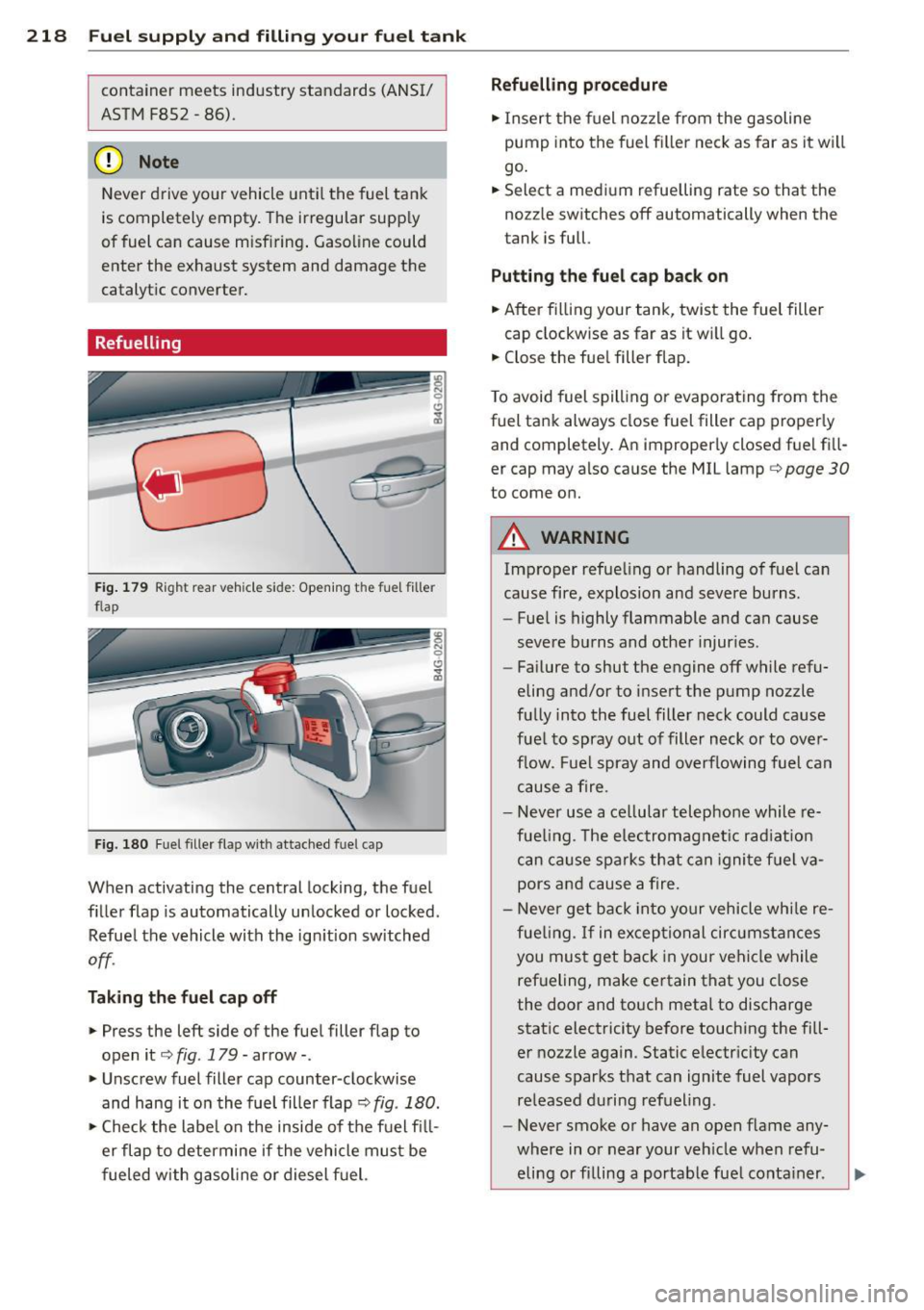
218 Fuel supply and filling your fuel tank
container meets industry standards (ANSI/
ASTM F852 -86) .
(D Note
Never drive your vehicle until the fuel tank
is completely empty. The irregular supply
of fuel can cause misfiring . Gasoline could
enter the exhaust system and damage the
catalytic converter.
Refuelling
Fig. 179 R ig ht rear v ehicl e side: Openin g th e fu el fille r
fl ap
Fig. 180 Fu el f iller flap with attached f uel cap
When activating the central locking, the fuel
filler flap is automatically unlocked or locked .
Refuel the vehicle with the ign ition switched
off .
Taking the fuel cap off
,. Press the left side of the fuel filler flap to
open it
c:> fig. 179 -arrow -.
,. Unscrew fuel filler cap counter -clockwise
and hang it on the fuel filler flap
c:> fig. 180.
,. Check the label on the inside of the fuel fill
er flap to determine if the vehicle must be
fueled with gasoline or diesel fuel.
Refuelling procedure
,. Insert the fuel nozzle from the gasoline
pump into the fuel filler neck as far as it will
go .
,. Select a med ium r efuelling rate so that the
no zzle switches off automatically when the
tank is full.
Putting the fuel cap back on
,. After filling your tank, twist the fuel filler
cap clockwise as far as it w ill go.
,. Close the fue l filler flap.
T o avoid fuel spilling or evaporating from the
fuel tank always close fuel filler cap properly
and completely. An improperly closed fuel fill
er cap may also cause the MIL lamp
c:> page 30
to come on.
A WARNING
Improper refue ling or handling of fuel can
cause fire, explosion and severe burns.
- Fuel is highly flammable and can cause
severe burns and other injur ies .
- Failure to shut the engine off while refu
eling and/or to insert the pump nozzle
fully into the fuel filler neck could cause
fuel to spray out of filler neck or to over
flow. Fuel spray and overflowing fuel can
cause a fire.
- Never use a cellular telephone while re
fue ling. The electromagnet ic rad iat ion
can cause sparks that can ignite fuel va
pors and cause a fire.
- Never get back into your vehicle whi le re
fueling.
If in exceptional circumstances
you must get back in your vehicle while
refueling, make certain that you close
the door and touch metal to discharge
static electricity before touching the fill
er nozzle again. Static electricity can
cause sparks that can ignite fuel vapors
released during refueling .
- Never smoke or have an open flame any
where in or near your veh icle when refu-
eling or filling a portable fuel conta iner . ..,
Page 222 of 304
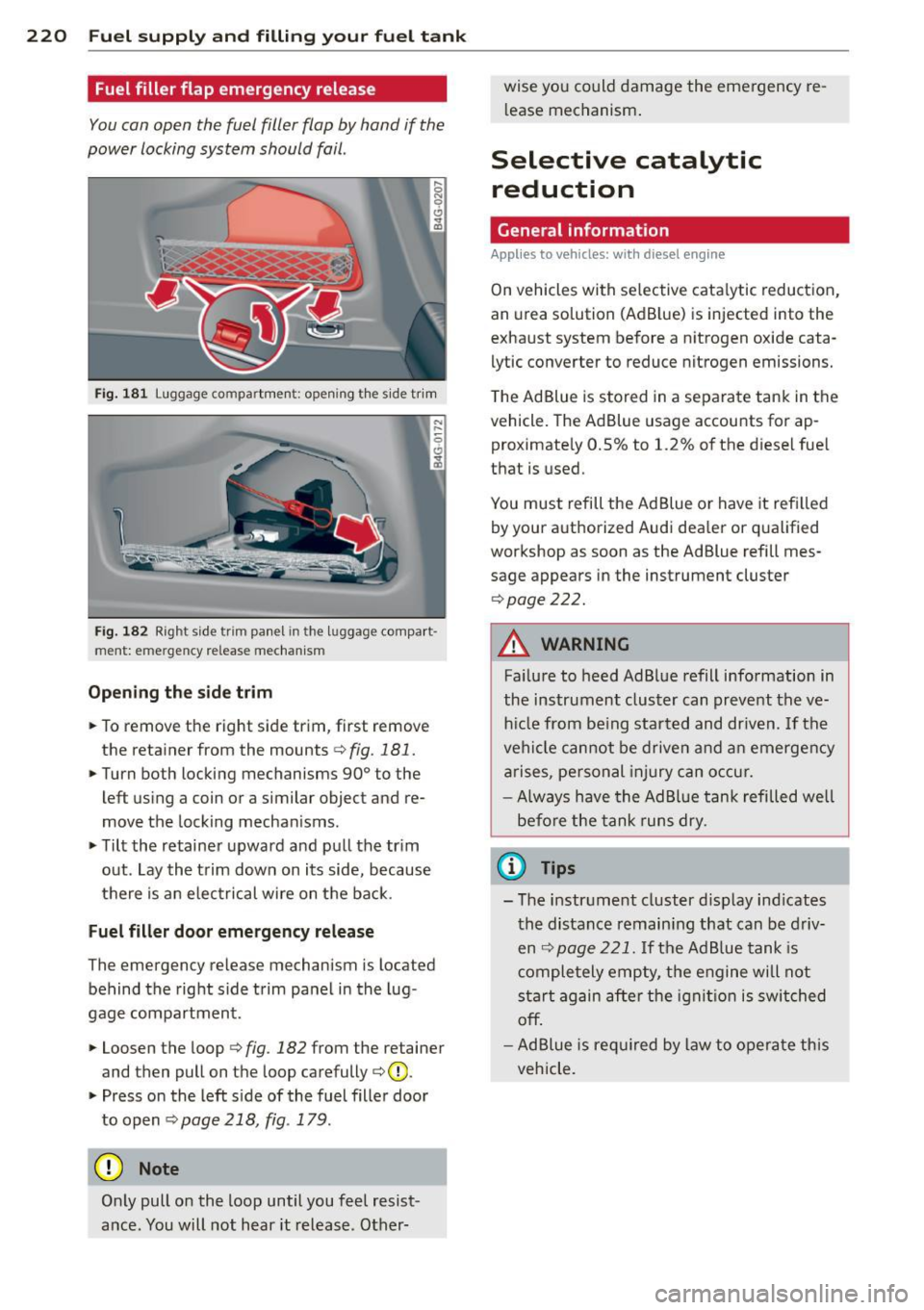
220 Fuel supply and filling your fuel tank
Fuel filler flap emergency release
You can open the fuel filler flap by hand if the
power locking system should fail .
Fig. 181 Luggage co m partmen t: open ing the side tr im
Fig. 182 Right side trim panel in the lu ggage compar t
ment: e mergency release mechanism
Opening the side trim
• To remove the right side trim, first remove
the retainer from the mounts
¢ fig. 181.
• Turn both locking mechanisms 90° to the
left using a coin or a similar object and re
move the locking mechanisms.
• Tilt the retainer upward and pull the trim
out . Lay the trim down on its side, because
there is an electrical wire on the back.
Fuel filler door emergency release
The emergency release mechanism is located
behind the right side trim panel in the lug
gage compartment.
• Loosen the loop i:>
fig. 182 from the retainer
and then pull on the loop carefully i:>Q).
• Press on the left side of the fuel filler door
to open
i=> page 218, fig. 179.
(D Note
Only pull on the loop until you feel resist
ance. You will not hear it release . Other- wise you could
damage the emergency re
l ease mechanism .
Selective catalytic
reduction
General information
Applies to vehicles: with diesel engine
On vehicles with selective cata lytic reduction,
an urea solution (Ad B lue) is injected into the
exhaust system before a nitrogen oxide cata
lytic converter to reduce nitrogen emissions.
The Ad Blue is stored in a separate tank in the
vehicle. The Ad Blue usage accounts for ap
proximately 0.5% to 1.2% of the diesel fuel
that is used.
You must refill the Ad Blue or have it refilled
by you r authorized Audi dea ler or qualified
workshop as soon as the Ad Blue refill mes
sage appears in the instrument cluster
¢page 222.
A WARNING
-Failure to heed AdBlue refill information in
the instrument cluster can prevent the ve
hicle from be ing started and driven . If the
vehicle cannot be driven and an emergency
arises, personal injury can occur.
- Always have the AdBlue tank refilled well
before the tank runs dry.
(D Tips
-The instrument cluster display ind icates
the distance remaining that can be driv
en
c> page 221. If the Ad Blue tank is
completely empty, the engine will not
start again after the ignition is switched
off.
-Ad Blue is required by law to operate this
vehicle.
Page 291 of 304
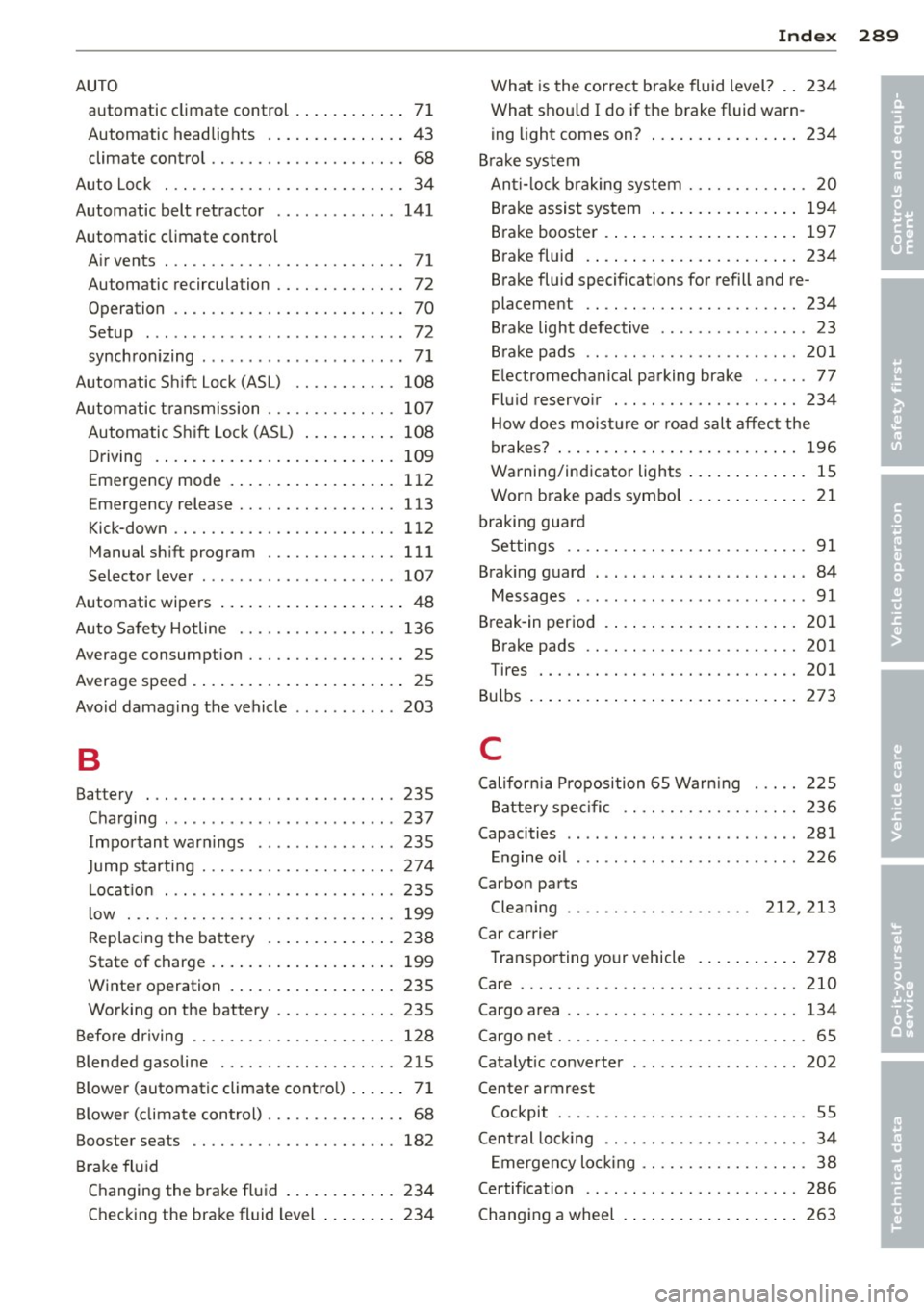
Index 289 ____________________________ ...:.:..:.=.:::.::.:
AUTO
automatic climate control . ... .. .. .. .. 71
Automatic headlights .... ... .. .. .. .. 43
climate control . . . . . . . . . . . . . . . . . . . . . 68
Auto Lock . . . . . . . . . . . . . . . . . . . . . . . . . . 34
Automatic belt retracto r ..... ...... .. 141
Automatic climate control Air vents ................ ...... .... 71
A t t· . l . u oma 1c recircu at1on . . . . . . . . . . . . . . 72
Operation . . . . . . . . . . . . . . . . . . . . . . . . . 70
Setup . .. ...................... ... 72
synchron izing ................... ... 71
Automatic Sh ift Lock (ASL) .. .. .. .. .. . 108
Autom atic t ransmission .............. 107
Automatic S hift Lock (ASL) ... .. .. .. . 10 8
D riving .... .. .... .... ... .. .. .. ... 109
Emergency mode . ..... ... .. .. .. .. . 1 12
Emergency release ........ .. .. .. .. . 113
Kick-down .. ............. .... .. ... 112
Manual s hift program .............. 111
Selector lever ..................... 107
Automatic wipe rs ... .... ... .. .. .. .. .. 48
Auto Safety Hotline ........ .. .. .. .. . 136
Average consumption ................. 25
Average speed . . . . . . . . . . . . . . . . . . . . . . . 25
Avo id damag ing the vehicle .. .. .. .. .. . 203
B
Ba ttery . .. .. .. .. .............. ... . 235
Cha rging ......................... 237
Impor tant war nings ...... .. .. .. .. . 235
J ump starting . ........... .. .. .. ... 274
L o cat ion . .. ............. .... .. ... 235
l ow . .. .. .. .... ............. .. .. . 199
Replacing the ba ttery .. ... .. .. .. .. . 238
State of charge . ... .... ... .. .. .. ... 199
Winte r operation . ..... ... .. .. .. .. . 235
Working on the battery ............. 235
B efore dr iving . . . . . . . . . . . . . . . . . . . . . . 128
Blended gasoline . ................ .. 215
Blower (automatic climate contro l) . . . . . . 71
B lower (climate control) . . . . . . . . . . . . . . . 68
Booster seats ............. .... .. ... 182
B rake fl uid
C hanging the brake fluid ... .. .. .. .. . 234
Chec king the brake fluid level ... .. .. . 234 What
is the correct bra ke fluid level? . . 234
What shou ld I do if the brake fluid wa rn -
i ng light comes on? .. .. ..... ... .. .. 234
B ra ke system
An ti-lock b rak ing system ........ .... . 20
B ra ke assis t sys tem .. ... .... ... .. .. 194
B rake booster . ...... .. .. ..... ... .. 197
Brake fluid . ... .. .. .. .. ...... ... .. 234
Brake fluid specifications for refill and re-
placeme nt .. .. .. ................. 234
B rake light defective . . . . . . . . . . . . . . . . 23
B ra ke pads .. .. .. .. . .. .... ...... .. 201
El ectromechan ica l pa rking brake ...... 77
Fl uid reservo ir ... ................. 234
H ow does moist ure or ro ad sal t affec t the
brakes? . . . . . . . . . . . . . . . . . . . . . . . . . . 196
Warning/ind icator lights ..... ... .. .. . 15
Wor n brake pads symbo l ..... ... .. .. . 21
braking gua rd
Settings .......................... 91
B rak ing guard . .. .. .... ....... ....... 84
Messages ......................... 91
Break-in per iod . ..... . .. .. ..... ... .. 201
Brake pads .. .. .. ................. 201
r ires ....... .. ...... ............ .
Bul bs . ... .. .. .... .. . .. .. ..... ... . .
C
201
273
Cali for nia Pr oposition 65 War ning . .. .. 22 S
B attery spe cific .. .... ...... ..... .. 236
Capacities ......................... 281
E ngine oil ... .. .. .. . .. .... ...... .. 226
Carbon parts
Cleaning . . . . . . . . . . . . . . . . . . . . 212, 213
Car car rier
T ranspo rting your vehicle .... ... .. .. 278
Care .......... .... ................ 210
Cargo area . . . . . . . . . . . . . . . . . . . . . . . . . 134
Cargo ne t . . . . . . . . . . . . . . . . . . . . . . . . . . . 6S
Catalytic converter 202
Center armrest
Cockpit ... .. .. .. ................. . 55
Central lo cki ng .. .. .... ............. . 34
E mergen cy lo ckin g ............. .. .. . 38
Ce rtif ication . . . . . . . . . . . . . . . . . . . . . . . 286
Changing a wheel .... . .. ..... ... .. .. 263
•
•